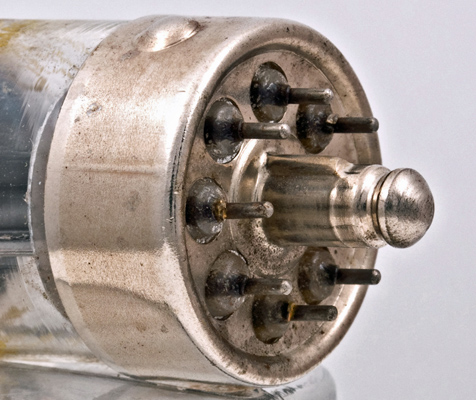|
Characteristics and Dimensions

This view of the metal base skirt clearly shows the locking groove on the central spigot.
The 'Loctal' (B8B) valves recently introduced, by Hygrade-Sylvania and Philco have a new base - of the octal variety which differs from the ordinary octal base. Although the pins will fit present octal sockets, the pin connections are different, and although the centre locating pin has the usual key to ensure correct insertion, it is grooved near the tip to engage a spring catch or lock in its own special type of socket. The current carrying base pins are set in the thickened glass base of the valve and supported entirely by it. The metal shell, of which the locating peg is a portion, has clearance holes through which the contact pins pass. The glass shells of the Loctal type are rather small, and to agree with the present tendency all Loctals are single ended.
Could we but undo the past here in America, we should certainly have fewer valves with octal bases, and certainly not two sorts of octal base. Perhaps then we should not so soon have come to the end of our alleged system of valve designations, which appears to have been abandoned in the Loctal series. Previously an initial 6 has meant operating filament voltage between 6 and 7, but in the Loctal series such valves have type designations beginning with a 7 instead of a 6, presumably because the system is at best vague, and the 6 combinations are so nearly used up that we are encountering such type numbers as 6AC5-G, 6J7-GT. The old system of arbitrary numbering was no worse.
The Loctal valves, however, are good. Their advantage lies in a desirable physical form, for their electrical properties are identical with, or very similar to, other valve types.
Some of the Loctal valves have 0.15A filaments. The variety is sufficient to permit their exclusive use in a midget receiver with series-connected heaters and no transformer. The smaller current and the higher voltage drops in the heaters of the rectifier and output valves of this series make it unnecessary to drop voltage in a resistance external to the receiver. Thus the usual flexible cord resistor (line cord) can be dispensed with. This resistor may not have caused any fires, but it certainly looks dangerous and has never been approved by the insurance underwriters who are final authorities in America on the safety of household electrical appliances.
In addition to the Loctal valves a new series of valves has appeared with the subscript GT. These are merely glass valves in a straight-sided tubular form. There are thus the following electrical equivalents: 6K7 (metal), 6K7G (glass), 6K7GT (tubular glass), and the near equivalents 6SK7 (single-ended metal) and 7A7 single ended glass Loctal).

Characteristics of the Loctal Valves. Click to enlarge.
The valves in the table above are: 1231, 7A6, 7A7, 7A8, 7B5, 7B6, 7B7, 7B8, 7C5, 7C6, 7Y4, 35A5 and 35Z3. The highlighted Types link to museum exhibits.
|